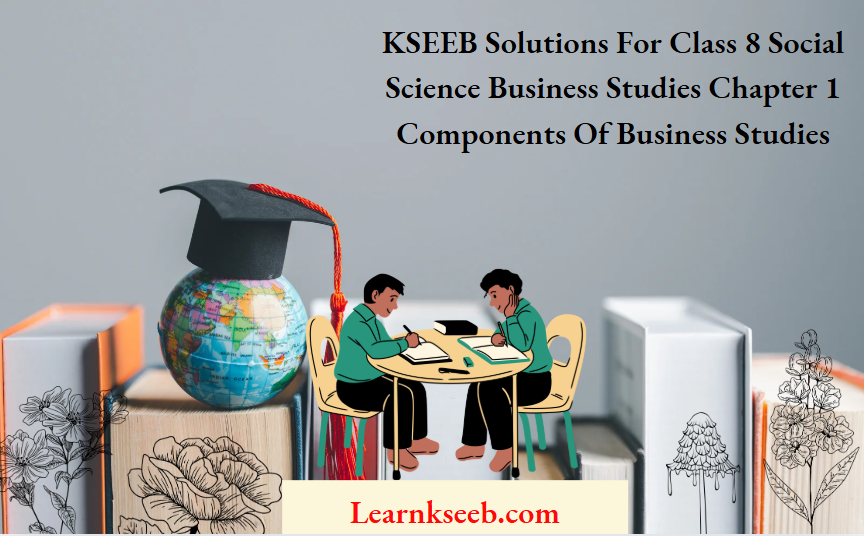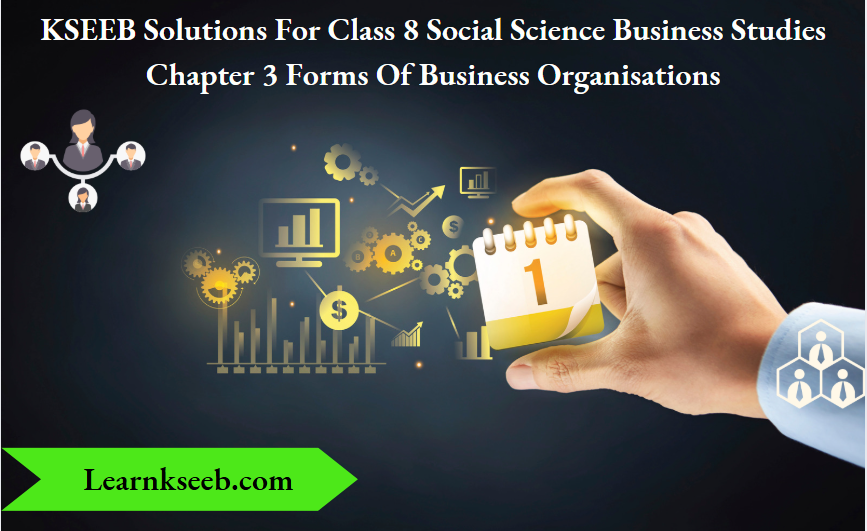KSEEB Solutions Class 8 Economics Chapter 4 Government And The Economy Points To Remember
Government plays an important role in promoting economic development and improving the welfare of the people. The government takes measures to overcome problems like unemployment, poverty, inflation, lack of basic facilities and inequality.
Planning refers to the deliberate actions of the government to systematically allocate and utilize available resources to achieve predetermined goals in the interest of all. Planning involves the identification of requirements, setting goals, mobilizing resources, designing action plans to utilize the resources and monitoring them and evaluating whether the goals are achieved or not.
Read and Learn More KSEEB Solutions for Class 8 Social Science
To perform all these activities, the Planning Commission was established in 1950.
The NFL Ayog aims at preparing long-run vision strategies as guideposts for steering the economy to achieve desired goals.
The size and growth rate of national and per capita incomes have both increased under the plan.
There has been a substantial improvement in the capital goods industry including iron and steel, machinery, chemical fertilisers, etc.
Development of agriculture, industry and defence, as increased income has increased the rate of capital formation has also.
The fundamental objective of Indian planning is to achieve growth with social justice.
Measures like land reforms, abolition of bonded labour, liquidation of rural indebtedness, fixation of minimum wages, provision of basic minimum needs, and reduction of the concentration of power and economic disparities have contributed towards achieving social justice.
The huge deficit in the trade balance, declining foreign exchange reserves, severe inflation, and very high budget deficit crippled the Indian economy and also a life of the people.
The new economic policy is also called ‘economic reforms. As these policies comprise liberalization, privatization and globalization they are also called LPG policies.
Economic reforms refer to the adoption of policies to eliminate market barriers, encourage economic participation from the private sector, reduce the fiscal deficit, increase exports and reduce imports, etc. to increase the growth rate of the economy.
Pradhan Mantri Fasal Bima Yojana provides insurance coverage for rabi and Kharif crops and financial support to farmers in case of damage to crops.
Pradhan Mantri Krishi Sinchayi Yojana helps irrigate the field of every farmer and improves water use efficiency to provide ‘Per Drop More Crop’.
Make in India was introduced to encourage multinational, as well as domestic companies to manufacture their products in India and create jobs and skill enhancement in 25 sectors.

Class 8 Economics Government And The Economy KSEEB Notes
Government And The Economy Answer the following questions in about two sentences each.
Question 1. Define planning.
Answer: Planning refers to the deliberate actions of the government to systematically allocate and utilize available resources to achieve predetermined goals in the interest of all.
Question 2. List the prominent objectives of planning in India.
Answer:
The general objectives of Indian planning are:
Increasing the rate of economic growth
Bring about modernization in the economy
Achieve self-reliance
Reduction in the inequality of income and wealth
Development of Infrastructure
Development of financial institutions
Balanced regional development
Promoting private
Question 3. What are the major failures of Indian planning?
Answer:
The major failures of Indian planning are:
Slow growth in Production and Income
Rise in Prices
Increase in Unemployment
Persisting Poverty and Inequality
Inefficient Administration
Increase in Exports not as expected
Question 4. Describe India’s economic situation during 1990-91.
Answer: During 1990-91 India faced serious economic problems. The huge deficit in the trade balance, declining foreign exchange reserves, severe inflation, and very high budget deficit crippled the Indian economy and also a life of the people.
Question 5. List the major initiatives under the economic reform measures.
Answer:
A liberal industrial policy invites foreign investment through the privatization of industries and abolishing the licensing system.
Automatic approval for Foreign Direct Investment (FDI) for many activities.
A liberal import-export policy for ensuring easy exports of Indian goods and obtaining the necessary raw materials.
Reforming the banking and financial sector in accordance with internationally accepted standards.
Reforms in the tax structure for ensuring higher coverage of taxpayers and increase the tax revenue.
Withdrawing and restricting government interference in investment and also privatization of public sector enterprises.
KSEEB Class 8 Government And The Economy Study Materials
Government And The Economy Additional Questions And Answers
Choose the correct alternative and Write the complete answer along with its alphabet in the sheet provided:
Question 1. The programme which creates jobs and skill enhancement in 25 sectors is
- Pradhan Mantri MUDRA Yojana
- Start-up India and Stand-up India
- Make in India
- Skill India
Answer: 3. Make in India
Question 2. The programme which started to provide support to all start-up businesses in all aspects of doing business in India is
- Pradhan Mantri MUDRA Yojana
- Start-up India and Stand-up India
- Make in India
- Skill India
Answer: 2. Start-up India and Stand-up India
Question 3. Small businesses/ start-ups or entrepreneurs can avail of loans under
- Pradhan Mantri MUDRA Yojana
- Start-up India and Stand-up India
- Make in India
- Skill India
Answer: 1. Pradhan Mantri MUDRAYojana
Question 4. The programme which is introduced to fulfil Mahatma Gandhi’s dream of a clean and hygienic India is
- Swatch Bharat Abhiyan
- Pradhan Mantri Jeevan Jyoti BimaYojana
- Pradhan Mantri Jan Dhan Yojana
- Skill India
Answer: 1. Swach Bharat Abhiyan
Question 5. The Skill India programme introduced to provide
- Employable skills
- Employment
- Monetary benefits
- Investments
Answer: 1. Employable skills
KSEEB Economics Chapter 4 Class 8 Multiple Choice Questions
Question 6. National Mission for Financial Inclusion to ensure access to financial services is
- Swatch Bharat Abhiyan
- Pradhan Mantri Jeevan Jyoti Bima Yojana
- Pradhan Mantri Jan Dhan Yojana
- Skill India
Answer: 3. Pradhan Mantri Jan Dhan Yojana
Question 7. The scheme which is open and available to all Indian citizens between the age of 18 to 50 years is
- Pradhan Mantri Jeevan Jyoti Bima Yojana
- Pradhan MantriAwas Yojana
- Pradhan Mantri Suraksha BimaYojana
- Atal PensionYojana
Answer: 1. Pradhan Mantri Jeevan Jyoti Bima Yojana
Question 8. The scheme which is open and available to all Indian citizens between the age of 18 to 70 years is
- Pradhan Mantri Jeevan Jyoti Bima Yojana
- Pradhan Mantri Awas Yojana
- Pradhan Mantri Suraksha BimaYojana
- Atal Pension Yojana
Answer: 3. Pradhan Mantri Suraksha BimaYojana
Question 9. The programme which is introduced for General Development
- Pradhan Mantri Gram Sadak Yojana
- Digital India
- Pradhan Mantri Krishi Sinchayi Yojana
- Pradhan Mantri Fasal Bima Yojana
Answer: 2. Digital India
Question 10. The programme which provides insurance cover for rabi and Kharif crops is
- Pradhan Mantri Gram Sadak Yojana
- Digital India
- Pradhan Mantri Krishi Sinchayi Yojana
- Pradhan Mantri Fasal Bima Yojana
Answer: 4. Pradhan Mantri Fasal Bima Yojana
Government And The Economy Answer the following questions in about two sentences each.
Question 1. What are LPG policies?
Answer: The policies comprise of liberalization, privatization and globalization are also called LPG policies.
Question 2. What are Economic reforms?
Answer: The need for reforming economic policy was widely felt and hence the new economic policy was initiated in 1991. The new economic policy is also called ‘economic reform.
Question 3. Why is the Pradhan Mantri Krishi Sinchayi Yojana introduced?
Answer: I migrating the field of every fanner and improving water use efficiency to provide ‘Per Drop More Crop’.
Question 4. Why is the Mahatma Gandhi National Rural Employment Guarantee Scheme introduced?
Answer: Legal guarantee for one hundred days of employment in every financial year to adult members of any rural household willing to do public work-related unskilled manual work a the statutory minimum wage.
Question 5. Why is the Pradhan Mantri Gram Sadak Yojana introduced?
Answer: Good all-weather road connectivity to unconnected villages.
Question 6. Why is Atal Pension Yojana started?
Answer: The scheme provides a monthly pension of Rs 1000 to Rs. 5000 per month based on the contribution amount targeted to the private unorganized sector and is open to all Indian citizens between the age of 18 to 40 years.
Question 7. Why is the AMRUT programme set up?
Answer: To enable better living and drive economic growth stressing the need for people-centric urban planning and development.
Question 8. Why is Pradhan Mantri Awas Yojana started?
Answer: To enable better living and drive economic growth stressing the need for people-centric urban planning and development.
Government And The Economy Answer the following questions in about six sentences each.
Question 1. What are the problems India faced after Independence?
Answer: Unemployment, poverty, inflation, lack of basic facilities and inequality are the problems India faced after Independence.
Question 2. Planning was adopted as the strategy to bring about all-around progress in the economy. Why?
Answer: The leaders responded positively and initiated several measures to bring about the overall socioeconomic development of the country. For this purpose, planning was adopted as the strategy to bring about all-around progress in the economy.
Question 3. Explain the programme for General Development introduced by the Government.
Answer:
Digital India: To ensure that government services are available to citizens electronically and people get benefited from the latest information and communication technology.
Question 4. Explain the programme for Agricultural and Rural Development introduced by the Government
Answer:
Pradhan Mantri Fasal Bima Yojana: Provide insurance cover to rabi and Kharif crops and financial support to farmers in case of damage to crops.
Pradhan Mantri Krishi Sinchayi Yojana: Irrigating the field of every farmer and improving water use efficiency to provide Ter Drop More Crop.
Mahatma Gandhi National Rural Employment Guarantee Scheme: Legal guarantee for one hundred days of employment in every financial year to adult members of any rural household willing to do public work-related unskilled manual work at the statutory minimum wage.
Pradhan Mantri Gram Sadak Yojana: Good all-weather road connectivity to unconnected villages.
Class 8 Economics Chapter 4 Guide On Government and the Economy KSEEB
Question 5.Explain the programme for Industrial development introduced by the Government
Answer:
Make in India: To encourage multi-national, as well as domestic companies to manufacture their products in India and create jobs and skill enhancement in 25 sectors
Startup India and Standup India: To provide support to all start-up businesses in all aspects of doing business in India.
Pradhan Mantri MUDRAYojana: Small businesses/ startups or entrepreneurs can avail of loans from Rs. 50 thousand to 10 Lakh to start/grow their business under the three, Shishu, Kishore and Tarun categories of the scheme.
Question 6.Explain the programme for the development of the Social Sector introduced by the Government
Answer:
Swatch Bharat Abhiyan: To fulfil Mahatma Gandhi’s dream of a clean and hygienic India.
Skill India: To provide encouragement to youth for the development of employable skills by providing monetary rewards by recognition of prior learning or by undergoing training at affiliated centres.
Pradhan Mantri Jan Dhan Yojana: National Mission for Financial Inclusion to ensure access to financial services, namely Banking Savings & Deposit Accounts, remittances, Credit, Insurance, and Pension in an affordable manner.
Pradhan Mantri Jeevan Jyoti Bima Yojana: Life insurance scheme aimed at increasing the penetration of life insurance coverage in India. The scheme is open and available to all Indian citizens between the age of 18 to 50 years.
Pradhan Mantri Suraksha Bima Yojana: Accident insurance scheme aimed at increasing the penetration of accidental insurance coverage in India, The scheme is open and available to all Indian citizens between the age of 18 to 70 years.
Atal Pension Yojana: The scheme provides a monthly pension of Rs 1000 to Rs. 5000 per month based on the contribution amount targeted to the private unorganized sector and is open to all Indian citizens between the age of 18 to 40 years.
Question 7.Explain the programme for Urban Development introduced by the Government
Answer:
Atal Mission on Rejuvenation and Urban Transformation (AMRUT): To enable better living and drive economic growth stressing the need for people-centric urban planning and development.
Pradhan Mantri Awas Yojana: To enable better living and drive economic growth stressing the need for people-centric urban planning and development.
Smart Cities Mission: To develop 100 cities all over the country making them citizen friendly and sustainable.




